The Mystery Snow BrigSome years have now past since this unique and mysterious find, and no investigation
is planned. If nothing is done soon, this ship may be wiped out by one of the
many trawler fishers of the Baltic Sea. |
||
|
Despite bad visibility near the bottom, the crew got a spectacular sight on their TV monitors – an old ship standing upright with its two masts standing and bowsprit, perfectly intact. The reason for sinking is a mystery, since both hull and rigging are intact. Snow brig
The snow brig was a common rigging for minor ships during the entire 18th century. One of the earliest snow brigs was “Mjöhunden”, built for the Swedish Navy by Charles Sheldon in 1698 and sunk in battle off Arkangelsk in 1701. Mjöhunden was 21 m long and carried six 3-pound guns. Later on, in the 19th century, the snow brig was gradually replaced by
the Golden seahorseThe figurehead on the wreck is a fantastic gilded horse with (human) hands clasped under its belly and a fish tail. The gunwales (shipsides) have deck-level gunports and at least one gunport seems to have been decorated. But there are no guns to be seen. Several planks and possible decorations of the sterncastle have fallen off, perhaps because they were attached with (now rusted) nails, while other planks are attached with wooden pegs. The ship seems to be a minor naval or postal ship, or maybe a private or Royal yacht. Skulls from at least two crewmen lie on the deck, which is unusual, since casualties usually float away during sinking. Perhaps those men were trapped. Why?Why did it sink? Ships that sink in storms usually lose parts of the rigging and suffer general damage. But this ship is in mint condition. Perhaps she had all sails set and was caught by a sudden wind, like the Hamilton and Scourge. Perhaps she suddenly started leaking. On the video, one of the skulls on the deck seems like it might have an axe buried in it. Strange. Could the ship have been taken by pirates or mutineers and then sunk to remove all trace? But there were hardly any pirates in the Baltic Sea in the18th century. Perhaps it was pirates, and they were unknown until now, since no witnesses were left alive... Identity?Questions, questions, questions... The identity and reason for sinking is still a mystery. Archival search may tell us more. But perhaps only a site investigation will tell for sure. Meanwhile, having seen the video, here are some notes:
Funding & action neededThe position is kept secret by the Swedish Navy, to prevent looting by treasure hunters. The idea is that an official investigation will be performed. But when? And who will pay? Presently neither the National Maritime Museum nor the Swedish Navy has the money for an investigation. If you have ideas on how to contribute to or finance an investigation, please feel free to contact the museum. Perhaps it's time for a national fundraising program, just like it was 40 years ago, when private donors and sponsors helped pay the Vasa project. Or perhaps this investigation can be co-produced with e.g. National Geographic. The possible investigationArchaeologist Bert Westenberg at the National Maritime Museum is presently (January 2004) hoping to find an outside partner that can provide resources for an investigation. According to Mr Westenberg, an investigation would primarily aim at dating and identifying the ship, by video documenting, by bringing up some loose objects, as well as sample wood for dendro dating. The HMS Belos would be rented from the Swedish Navy for the operation (they don't do it for free), and would have these resources:
Mr Westenberg, if you had the resources now, when would an investigation start? – If we started planning now, we could expect to be on-site during the spring of 2005, says Bert Westenberg. Mr Westenberg's museum is fighting a battle against time. Two years have passed, and as time passes, this ship may be wiped out by one of the many trawler fishers of the Baltic Sea. Per Åkesson Links
Articles
Some newspaper articles online are in Swedish but the photos and reconstruction drawings are good. Have a look! On request I can write more articles in English, Swedish or German and negotiate the image rights. This ship seems to be the most interesting wreck find in the Baltic area for some time. Any further news on this one will be posted on this page. * Perhaps the Navy was searching for a Swedish DC3 spy plane that was shot down in 1952, but that's a different story. |
present state of the wreck gilded figurehead horse from the video, courtesy
Swedish Navy figurehead from the video, courtesy Swedish
Navy, note the horse's fingers, clasped under its belly bow section interpretation with figurehead original ship interpretation, the Swedish
flags are pure speculation, the ship could just as well be Russian or
Danish crosstrees on fore topmast,
from the video, courtesy Swedish Navy top on forward mast, from the video, courtesy Swedish Navy |
|
a rewrite of this article can be ordered for publishing, all drawings by naval artist Axel Nelson, page rev apr '10
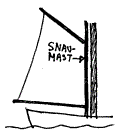 The ship
is 26 m long and the masts rise about 20 m, with perfectly-preserved tops
(platforms) about halfway. The rigging is clearly a
The ship
is 26 m long and the masts rise about 20 m, with perfectly-preserved tops
(platforms) about halfway. The rigging is clearly a 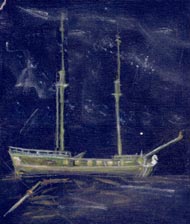

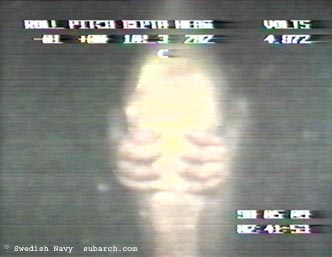
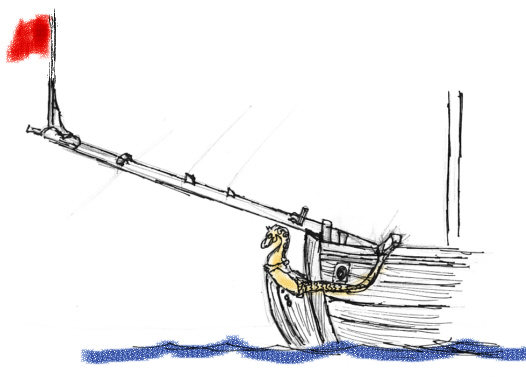
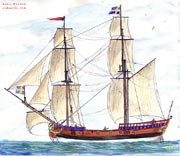
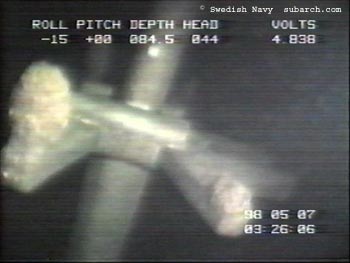
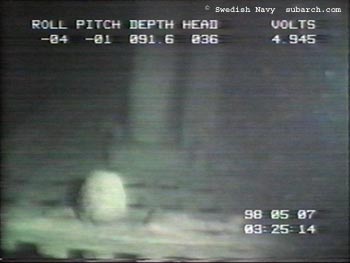
 Back to Nordic Underwater Archaeology
Back to Nordic Underwater Archaeology